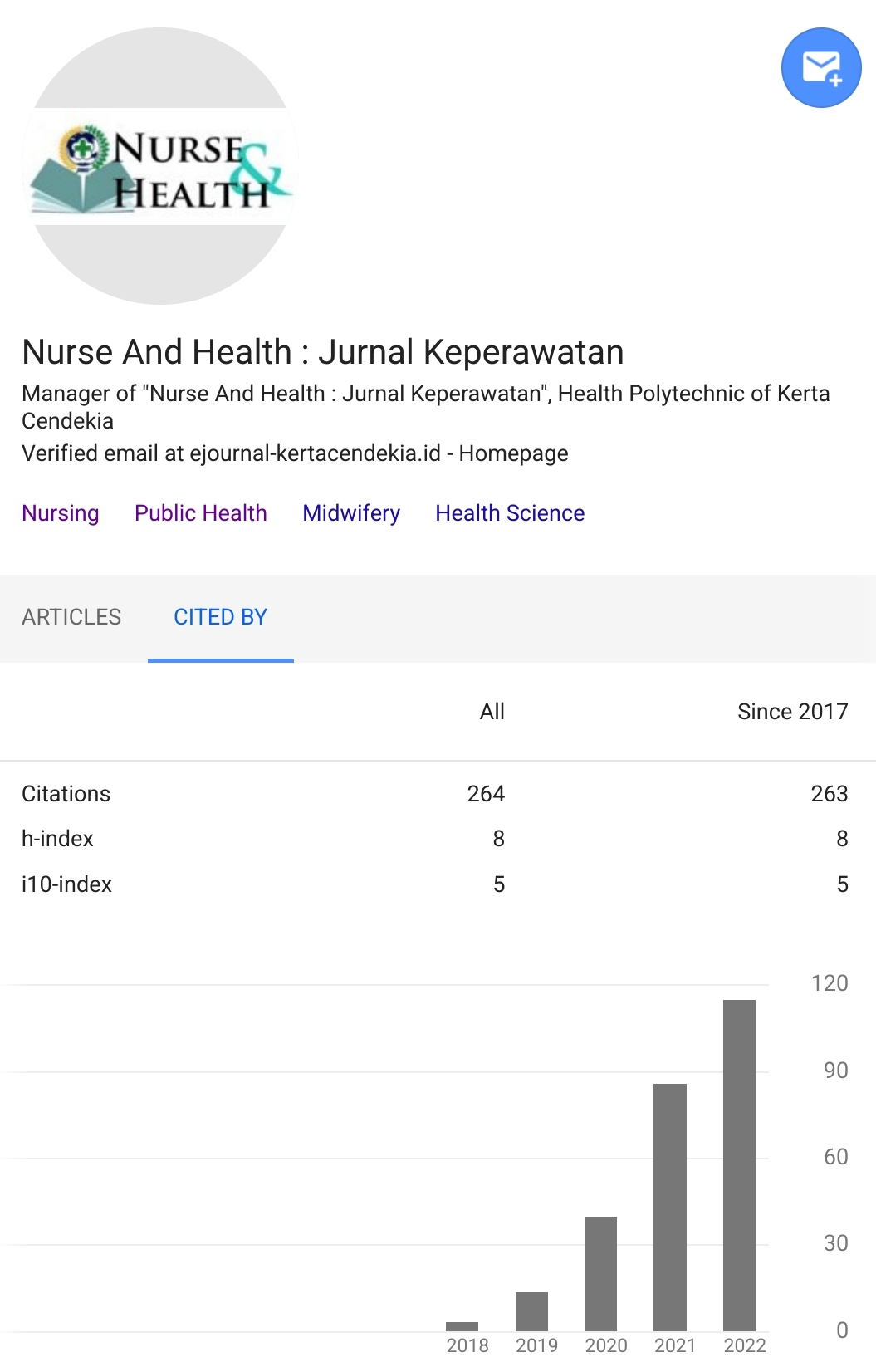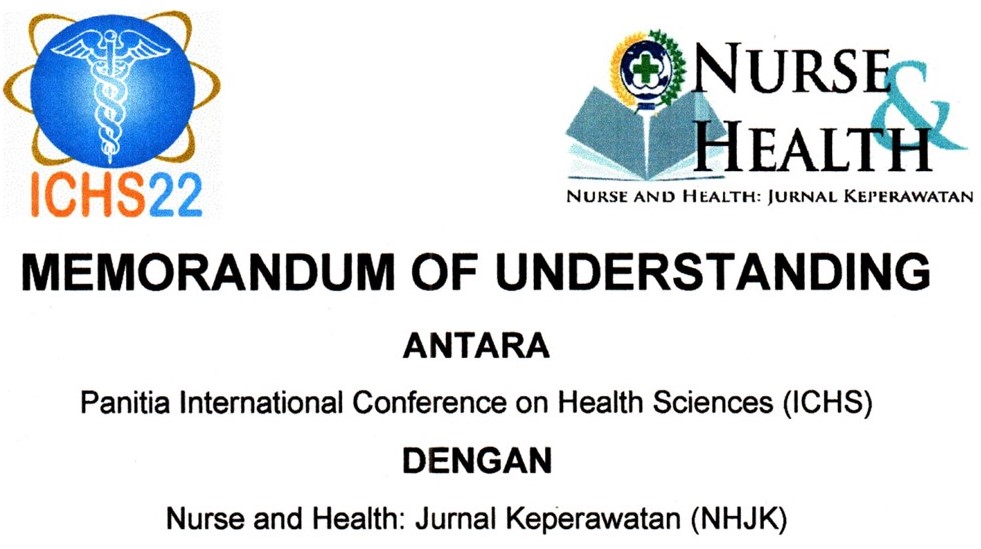SPIRITUAL EMOTIONAL FREEDOM TECHNIQUE TO IMPROVE SLEEP QUALITY FOR POSTPARTUM MOTHERS
Abstract
Background: Sleep quality disorders are a problem that postpartum mothers often experience. The postpartum is the period after giving birth or commonly called the puerperium, which is the period after giving birth that is needed to restore the uterine organs. Post-partum mothers experience sleep quality disorders both due to new roles and changes during the postpartum period. Sleep quality that is not treated properly can bring changes that can affect physical and psychological problems. Thus, it needs to interfere with the sleep quality of post-partum mothers. Objectives: This study aimed to prove that the Spiritual Emotional Freedom Technique (SEFT) was also beneficial in improving sleep quality in postpartum mothers. Methods: This study used a quasi-experimental pre-and post-test design with a control group. The research subjects were 56 postpartum mothers treated at Sultan Agung Islamic Hospital Semarang in June and September 2021, divided into intervention and control groups. The intervention was carried out twice a week for four weeks, with a SEFT duration of 20 minutes. The control group received standard therapy in the form of dhikr therapy. The Pittsburgh sleep quality index (PQSI) questionnaire used seven assessment components to measure research outcomes. The univariate analysis used central tendency in the form of the mean, median, and standard deviation. The different test of sleep quality before and after the intervention in the intervention group was carried out by the Wilcoxon match pair test (abnormal distribution), while the control group used paired t-test (normal distribution). For the mean difference test between groups, it used Mann Whitney test. Results: The mean score of sleep quality in the intervention group before treatment was 10,86 + 1,79 (poor sleep quality) and after treatment decreased significantly (p=0,00) to 5,25 + 1,46 (still in poor sleep quality). The quality of sleep in the control group before treatment was 10,89 + 1,89 and after the intervention was 10,71 + 2,35 with p=0,47. The components of subjective sleep quality, sleep latency, sleep duration, and sleep disturbance in the intervention group were significantly lower than in the control group. Conclusion: The SEFT intervention can significantly improve sleep quality in postpartum mothers, but it is still in the poor category. Besides, the sleep quality score can be considerably improved, especially in four of the seven components.Downloads
References
Arnata, A. P., & Lestari, P. (2018). Pengaruh Terapi Spiritual Emosional Freedom Technique Terhadap Peningkatan Kualitas Tidur pada Lansia di Desa Gondoriyo Kecamatan Bergas Kabuapten Semarang. Indonesian Journal of Nursing Research, 1(1), 1–14. DOI: https://doi.org/10.35473/ijnr.v1i1.3
Bobak, Lowdermilk, & Jensen. (2014). Buku Ajar Keperawatan Maternitas. Jakarta: EGC.
Church, D Garret Yount, Audrey., J. B. (2012). The effect of emotional freedom techniques on stress biochemis7try: A randomized controlled trial. Journal of Nervous and Mental Disease, 200(10), 1–7. https://doi.org/10.1097/NMD.0b013e31826b9fc1 DOI: https://doi.org/10.1097/NMD.0b013e31826b9fc1
Church, D. (2013). Clinical EFT as an Evidence-Based Practice for the Treatment of Psychological and Physiological Conditions. Psychology, 4(8), 1–10. https://doi.org/10.4236/psych.2013.48092 DOI: https://doi.org/10.4236/psych.2013.48092
Clond M. (2016). Emotional Freedom Techniques for Anxiety: A Systematic Review with Meta-analysis. The Journal of Nervous and Mental Disease, 204(5), 388–395. https://doi.org/10.1097/NMD.0000000000000483 DOI: https://doi.org/10.1097/NMD.0000000000000483
Cole JC, Motivala SJ, Buysse DJ, Oxman MN, Levin MJ I. M. (2006). Validation of a 3-Factor Scoring Model for the Pittsburgh Sleep Quality Index in Older Adults. Sleep, 29(1), 112–116. DOI: https://doi.org/10.1093/sleep/29.1.112
Dina Zakiyyatul Faudah, N. T. (2017). Pengaruh Pijat Oksitosin Pada Ibu Post Partum terhadap Pemenuhan Kebutuhan Istirahat Tidur. Jurnal Sain Med-Jurnal Kesehatan, 9(2), 96–101. https://doi.org/2085-3602
Dorheim SK, Bondevik GT, Eberhard- Grand M, Bjorvatn B. (2009). Sleep and Depression in Postpartum Women: A Population-Based Study. Sleep, 32(7), 847–855. DOI: https://doi.org/10.1093/sleep/32.7.847
Fatmawati, R., & Hidayah, N. (2019). Gambaran Pola Tidur Ibu Nifas. Journal Infokes, 9(2), 1–4. https://doi.org/2086-2628
Kementerian kesehatan RI. (2018). Kementerian Kesehatan Republik Indonesia. In Kementerian Kesehatan RI (Vol. 1, pp. 365–404).
Laura, D. de. (2015). Efektifitas Aromaterapi Lavender Terhadap Kualitas Tidur Ibu Post Partum. Journal JOM, 2(2), 1–8. https://doi.org/10.12816/0013114 DOI: https://doi.org/10.12816/0013114
Lebis, P., & Wahyuni, Z., I. (2019). Pengaruh Dukungan Sosial, Self-Esteem Dan Self-Efficacy Terhadap Orientasi Masa Depan Pada Remaja Akhir. TAZKIYA: Journal of Psychology, 5(1), 65–77. https://doi.org/10.15408/tazkiya.v22i1.8160 DOI: https://doi.org/10.15408/tazkiya.v22i1.8160
Marni. (2012). Asuhan Kebidanan Pada Masa Nifas (Puerperium Care). Yogyakarta: Pustaka Pelajar.
Mindell, J. A., Sadeh, A., Kwon, R., & Goh, D. Y. T. (2013). Cross-cultural comparison of maternal sleep. Sleep, 36(11), 1699–1706. https://doi.org/10.5665/sleep.3132 DOI: https://doi.org/10.5665/sleep.3132
Rahman, F,, Handayani, R, S. (2019). Pengaruh Terapi Relaksasi Benson Terhadap Kualitas Tidur Lansia Di Upt Pelayanan Sosial Lanjut Usia Bondowoso. Jurnal Sain Health, 3(1), 1–6. https://doi.org/2549-2586 DOI: https://doi.org/10.51804/jsh.v3i1.323.15-20
Safitri, R. P., & Sadif, R. S. (2013). Spiritual Emotional Freedom Technique (SEFT) to Reduce Depression for Chronic Renal Failure Patients are in Cilacap Hospital to Undergo Hemodialysis. International Journal of Social Science and Humanity, 3(3), 1–4. https://doi.org/10.7763/ijssh.2013.v3.249 DOI: https://doi.org/10.7763/IJSSH.2013.V3.249
Sari, R. (2020). Intervensi Non Farmakologi untuk Meningkatkan Kualitas Tidur Postpartum: Kajian Literatur. Journal of Holistic Nursing and Health Science, 2(3), 1–11. Retrieved from https://ejournal2.undip.ac.id/index.php/hnhs DOI: https://doi.org/10.14710/hnhs.3.2.2020.59-69
Stapleton P, Crighton G, & Sabot D, O. H. (2020). Reexamining the effect of emotional freedom techniques on stress biochemistry: A randomized controlled trial. Psichol Trauma, 12(8), 869–877. DOI: https://doi.org/10.1037/tra0000563
Susilawati, & Kasron. (2018). Perbandingan Efektifitas Spiritual Emotional Freedom Technique dan Progressive Muscle Relaxation Untuk Meningkatkan Kualitas Tidur Penderita Hipertensi di Cilacap Selatan. 6(1), 1–8. DOI: https://doi.org/10.32922/jkp.v6i1.46
Vangsapalo, D. (2010). Emotional freedom technique (EFT): terapi modern yang mengubah hidup anda. In Quantum Succes Training & Coaching. Tangerang: Quantum Succes Training & Coaching.
Widhiyanti, A. (2017). Pemberian back massage durasi 60 menit dan 30 menit meningkaatkan kualitas tidur pada mahasiswa VIA penjaskesrek FPOK IKIP PGRI bali semester genap tahun 2016/2017. Jurnal Pendidikan Kesehatan Rekreasi, 3(1), 1–10.
Zainuddin, A. F. (2012a). SEFT for Healing and succes, happiness and greatness. Jakarta: Afzan Publishing.
Zainuddin, A. F. (2012b). Spiritual emotional freedom technique (SEFT). Jakarta: Afzan Publishing.
Copyright (c) 2023 NANA ANDRIANA, Tri Nur Kristina, Dwi Susilawati

This work is licensed under a Creative Commons Attribution-NonCommercial 4.0 International License.
Authors who publish with Nurse and Health: Jurnal Keperawatan agree to the following terms:
- Authors retain copyright licensed under a Creative Commons Attribution-NonCommercial 4.0 (CC BY-NC 4.0), which allows others to remix, tweak, and build upon the authors' work non-commercially, and although the others' new works must also acknowledge the authors and be non-commercial, they don't have to license their derivative works on the same terms.
- Authors are permitted and encouraged to post their work online (e.g., in institutional repositories or on their website) prior to and during the submission process, as it can lead to productive exchanges, as well as earlier and greater citation of published work (See The Effect of Open Access). Authors can archive pre-print and post-print or publisher's version/PDF.








_resize1.jpg)















